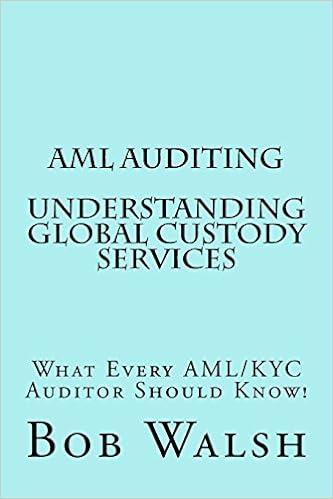Please answer the following discussion: Focus on the issue of auditor knowledge of the industry in which the client operates. Discuss the Lincoln Savings and
Please answer the following discussion:
Focus on the issue of auditor knowledge of the industry in which the client operates. Discuss the Lincoln Savings and Loan audit failure related to lack of industry knowledge. Consider whether there are any industries for which audits do not require particular industry expertise on the part of the audit partner. How does rotation of the audit partner (as required by SOX and the SEC) interact with the need for industry knowledge and risk of performing an audit?
Until the early 1980s, Lincoln was, like all other S&Ls at the time, heavily regulated. Almost half of its assets were investments in home mortgages and only a quarter of its assets were in risky vehicles. It had shown a loss for several years until it made a profit of a few million dollars in 1983.
American Continental Corporation (ACC) purchased Lincoln in February 1984 for $51 million and Charles Keating, chairman of ACC became its head. Keating fired the existing management and, over the next four years, Lincoln's assets increased from $1.1 billion to $5.5 billion. One of the reasons for this tremendous growth was that savings and loans had been deregulated in the early 1980s, which allowed them to make highly risky investments with their depositors' money. Lincoln was no exception; it, too, invested more of its depositors' money in risky investments.
One alleged fraud occurred when Keating acquired Lincoln. Apparently, Keating allocated little of the purchase price to the loan portfolio (i.e., it undervalued the loans) and the majority to other assets. Later, when Lincoln sold the loans at their fair value, large gains resulted which made Lincoln appear more profitable than it should have.
Because of a shortage of S&L examiners, Lincoln was not examined seriously until 1986. At that time, examiners discovered that Lincoln had exceeded the 10% regulatory limit on direct investments by $600 million. Because of this and because of evidence that Lincoln was deliberately trying to mislead examiners, the examiners recommended that the federal government seize Lincoln and its assets. The examination had become an investigation.
In response, Keating engaged 77 law firms to challenge the foreclosure and accused the examiners of bias. He bragged that he spent $50 million fighting regulators. In addition, he pressured the "Keating Five" (Cranston, DeConcini, Glenn, McCain, and Riegle) to stop regulators from closing Lincoln. These politicians complained to Edwin Gray, the chairman of the FHLBB, that the regulators were being too tough on Lincoln and implored them to quit dragging out the investigation.
The meeting had been set up by Charles Keating. After Edwin Gray was replaced by Dan Wall, the examiners were removed from the investigation and Lincoln was not contacted for ten months. Because of his involvement in the Keating Five affair, Wall was forced to resign.
When ACC, the parent of Lincoln Savings, went bankrupt in 1989, approximately 23,000 investors, many of whom were elderly, lost their life savings. Their total loss was approximately $285 million, largely because such investors held securities backed by the parent company rather than deposits in the federally insured institution, something many of them didn't realize when they invested in investments backed by ACC.
These investments were sold in the lobbies of Lincoln's braches, a federally-insured institution, so their safety seemed assured.] The federal government covered almost $3 billion of Lincoln's losses when it seized the institution. Many creditors were made whole, and the government then attempted to liquidate the seized assets through the Resolution Trust Corporation (RTC) often at pennies on the dollar compared to what the investments had allegedly been worth. Charles Keating was sent to prison for securities fraud and served 4.5 years.
In addition to making risky investments, Lincoln engaged in churning transactions. For example, the highly-competitive Arizona real estate market was experiencing a downturn (after an upturn in 1985-1986) in terms of total value of commercial real estate projects available and a slowdown of the increase in people moving into Arizona. Lincoln bought land for the Hidden Valley project at an average of $3,100/acre during 1985 and 1986 and sold this same land for $14,000 to $17,500 per acre in 1988. In early 1988, the Phoenix Business Journal reported that the Arizona construction industry had been in a recession for at least two years. [Recall that the real estate market back then was not as lucrative as the market that preceded the real estate crash in 2008-2009.]
Lincoln S&L's Auditors
Three auditing firms were involved: (1) Andersen (began auditing American Continental Corporation (ACC) in 1981 and Lincoln since ACC had acquired it in 1984 until it resigned in 1985), (2) Arthur Young (had audited ACC and Lincoln from 1985 until 1988) and (3) Touche Ross in 1988-1989.
Arthur Young committed the most egregious audit failures. In fact, some sources imply that AY should have known a problem existed when Anderson resigned as auditor of ACC. ACC was the largest audit client of Andersen's Phoenix office with annual audit fees in excess of $1 million. A resignation of that importance is not taken lightly by a firm like Andersen.
Furthermore, according to the 8-K filed by ACC to report the resignation, the explanation was "...the resignation is the result of AA's concern over potential liability in representing certain savings and loans in view of the very litigious environment controlled by regulators ...and AA's concern over the considerable publicity generated by the FHLBB's and its chairman, Mr. Gray's disagreements with the policies of the Registrant."
Step by Step Solution
There are 3 Steps involved in it
Step: 1

See step-by-step solutions with expert insights and AI powered tools for academic success
Step: 2

Step: 3

Ace Your Homework with AI
Get the answers you need in no time with our AI-driven, step-by-step assistance
Get Started


